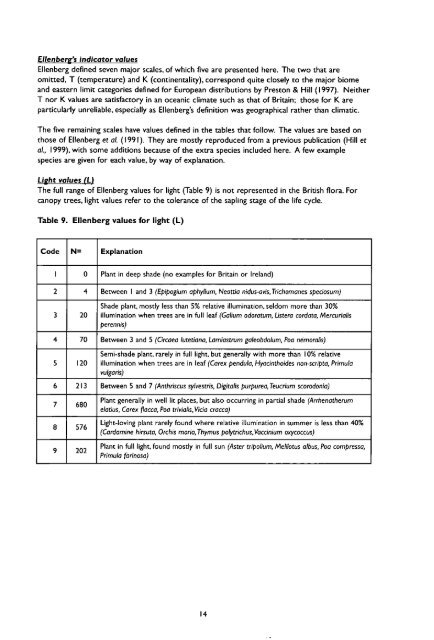Attributes of British and Irish Plants - Natural Environment Research ...
Attributes of British and Irish Plants - Natural Environment Research ...
Attributes of British and Irish Plants - Natural Environment Research ...
You also want an ePaper? Increase the reach of your titles
YUMPU automatically turns print PDFs into web optimized ePapers that Google loves.
Ellenbe s indicator values<br />
Ellenberg defi ned seven major scales, <strong>of</strong> which fi ve are presented here. The two that are<br />
omitted, T (temperat ure) <strong>and</strong> K (cont inentality), correspond quite closely to the major biome<br />
<strong>and</strong> east ern limit categories defi ned for European dist ribut ions by Preston & Hill (1997). Neither<br />
T nor K values are satisfactory in an oceanic climate such as that <strong>of</strong> Britain; t hose for K are<br />
particularly unreliable, especially as Ellenberg's defi nition was geographical rather than climat ic.<br />
The fi ve remaining scales have values defi ned in the tables that follow. The values are based on<br />
those <strong>of</strong> Ellenberg et at (1991). They are mostly reproduced from a previous publication (Hill et<br />
al., 1999), with some additions because <strong>of</strong> the ext ra species included here. A few example<br />
species are given for each value, by way <strong>of</strong> explanation.<br />
Light values (L)<br />
The full range <strong>of</strong> Ellenberg values for light (Table 9) is not represent ed in the <strong>British</strong> fl ora. For<br />
canopy t rees, light values refer to the tolerance <strong>of</strong> t he sapling stage <strong>of</strong> the life cycle.<br />
Table 9. Ellenberg values for light (L)<br />
Code N = Explanat io n<br />
0 Plant in deep shade (no examples for Britain or Irel<strong>and</strong>)<br />
2 4 Between 1 <strong>and</strong> 3 (Epipogium aphyllum, Neottia nidus-avis,Trichomenes speciosum)<br />
Shade plant, most ly less than 5% relative illuminat ion, seldom more than 30%<br />
3 20 illumination when t rees are in full leaf (Ga hurn odoraturn, Listera cordate, Mercurialis<br />
perennis)<br />
4 70 Between 3 <strong>and</strong> 5 (Circaea lutetiono, Lamiastrum galeobdolum, Poa nérnoralis)<br />
Semi-shade plant, rarely in full light, but generally with more than 10% relat ive<br />
5 120 illumination when t rees are in leaf (Carex pendula, Hyacinthoides non-scripta, Primula<br />
vulgaris)<br />
6 2 13 Between 5 <strong>and</strong> 7 (Anthriscus sylvestris, Digitalis purpurea, Teucriurn scorodonia)<br />
7 680<br />
8 576<br />
9 202<br />
Plant generally in well lit places, but also occurring in part ial shade (Arrhenatherurn<br />
elatius, Carex flacco, Poo trivialis,Vicia cracca)<br />
Light-loving plant rarely found where relat ive illumination in summer is less than 40%<br />
(Cardarnine hirsute, Orchis morio,Thymus polytrichus,Vacciniurn oxycoccus)<br />
Plant in full light, found mostly in full sun (Aster tripolium, Mel/ lotus albus, Poa compressa,<br />
Primula farinosa)<br />
14

















